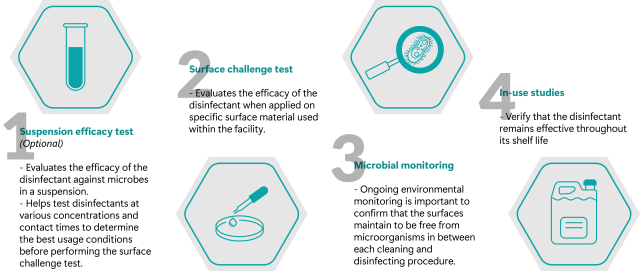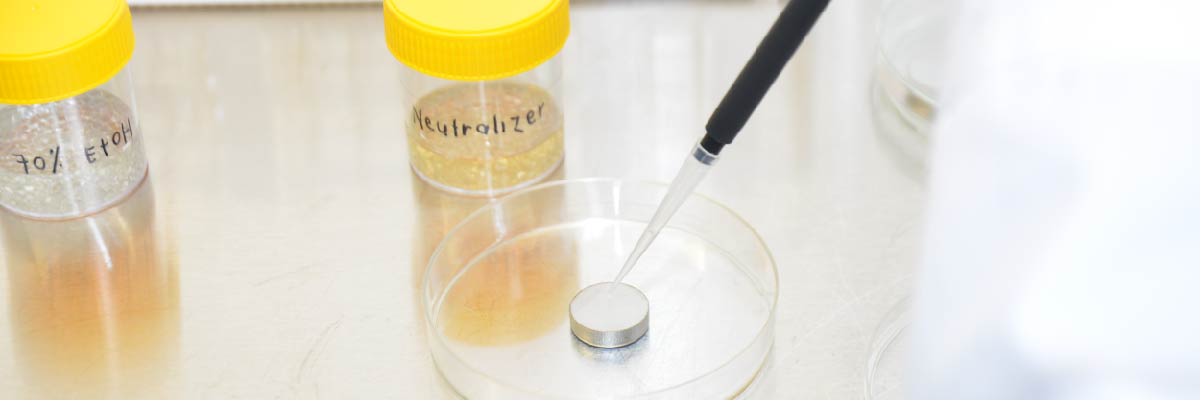USP 1072
“Here’s the disinfectants we could use for our cleanroom facility, now what?” – Pharmaceutical manufacturing companies for medicinal products are to comply to the requirements set out in the PIC/S Guidance Document for Guide to Good Manufacturing Practice (GMP) for Medicinal Products in order to obtain the necessary certifications. While this is a heavy document, let’s just focus on a section in Annex 1, specifically on the elements and implementation of Contamination Control Strategy (CCS) which includes the cleaning and disinfection of cleanrooms according to a validated written procedure.
“Why should the disinfectants still be validated if they have been tried and tested, known to be effective, hence the ability to list extensive claims for the products?” – The way products are tested for their claims on the label may not always fully reflect real-world usage, especially so in the exact way it is to be used within the cleanroom. Furthermore, product registration requirements generally do not address how disinfectants are used or what disinfectants have to achieve when used within the pharmaceutical industry. Therefore, to ensure the disinfectant demonstrates its suitability and effectiveness within the facility, the disinfection procedure utilized in cleanrooms should be validated
- in the specific manner in which they are used,
- on the type of surface material to which it is applied,
- by testing against standard test microorganisms as well as those that are typical environmental isolates, and
- to support the in-use expiry periods of the disinfectants
“How should one validate their disinfection procedure?” – While the GMP guide outwardly states that the disinfection procedure has to be validated, it does not specify how or according to any specific international standard methods nor mentioning the passing criteria to that should be achieved for the procedure to be deemed effective. Nonetheless, pharmaceutical manufacturers are obligated to include validation studies for their established standard operating procedure (SOP).
If you’re unsure where to start, the current USP 1072 under “Disinfectant Challenge Testing” provides recommendations to demonstrate the efficacy of disinfectants. We have summarized these guidelines along with our expert opinion to help guide you through the process. Consider this as your guide to planning your disinfectant efficacy validation study for your pharmaceutical manufacturing facility. Overall, disinfectant efficacy studies include the following:

Now, let’s dive in deeper to understand what tests should you do and how these tests work.
Screening of disinfectant efficacy
USP 1072 recommends that pharmaceutical manufacturers screen the efficacy of disinfectants used at different concentrations and contact times against a wide range of standard test microorganisms and environmental isolates. If following US regulations, the AOAC Use-Dilution Test is recommended. However, under EU regulations, the EN Suspension Test can be used. We recommend the EN Suspension Test, as it is a quantitative method that determines log reduction, while the AOAC Use-Dilution Test is a qualitative method.
Depending on the regulatory requirements in your region, this test may be optional in your validation procedure. This is because the ultimate goal of the validation procedure is to reflect the real-life usage of the disinfectant in your facility, and the data from this test may not fully contribute to that purpose and additional data may be needed.
That said, why do this test? The suspension test serves as a great entry point into disinfectant efficacy testing. It is a cost-effective way to experiment with various test conditions to identify the most practical usage conditions before moving to the next steps.
Surface Challenge Test
Most standard laboratory methods use stainless steel as the test surface. However, the efficacy of a disinfectant can vary depending on the type of surface it is applied to. Therefore, surface challenge testing is a critical part of the validation process for pharmaceutical manufacturers to ensure that the disinfectant remains effective across different surface materials.
| Table 1. Typical surfaces to be decontaminated by disinfectants in a pharmaceutical manufacturing area | |
| MATERIALS | APPLICATION EXAMPLE |
| Stainless steel 304L and 316L grades | Work surfaces, filling equipment, and tanks |
| Glass | Windows and vessels |
| Plastic, vinyl | Curtains |
| Plastic, polycarbonate | Insulation coating |
| Lexan® (plexiglass) | Shields |
| Epoxy-coated gypsum | Walls and ceilings |
| Fiberglass-reinforced plastic | Wall paneling |
| Tyvek® | Equipment wraps |
| Terrazzo tiles | Floors |
| *adapted from USP 1072 Disinfectants and Antiseptics, Table 6 | |
In this test, specific surface materials found on-site (examples shown in Table 1) should be used as test carriers to closely reflect real-life application within the facility. Both standard challenge microorganisms and environmental isolates (examples in Table 2) should be included in the test.
The disinfectant must meet the passing criteria defined by the manufacturer. According to USP 1072, the disinfectant should demonstrate at least a 2-log reduction for bacterial spores and a 3-log reduction for vegetative bacteria. In comparison, EN 13697:2023 sets a more stringent requirement: at least a 4-log reduction for vegetative bacteria and a 3-log reduction for fungi.
Manufacturers may choose to follow either USP 1072 or EN 13697 standards for passing criteria, subject to agreement with the auditor.
| Table 2. Typical challenge organisms that may be employed | ||
| AOAC CHALLENGE ORGANISMS | EN CHALLENGE ORGANISMS | TYPICAL ENVIRONMENTAL ISOLATES |
| Bactericide: Escherichia coli ATCC 11229 Staphylococcus aureus ATCC 6538 Pseudomonas aeruginosa ATCC 15442 |
Bactericide: Escherichia coli ATCC 10536 Staphylococcus aureus ATCC 6538 Pseudomonas aeruginosa ATCC 15442 Enterococcus hirae ATCC 10541 |
Bactericide: Micrococcus luteus Staphylococcus epidermidis Coynebacterium jeikeium Brevundimonas vesicularis (formerly known as Pseudomonas vesicularis) |
| Fungicide: Candida albicans ATCC 10231 Penicillium chrysogenum ATCC 11709 Aspergillus brasiliensis ATCC 16404 |
Fungicide: Candida albicans ATCC 10231 Aspergillus brasiliensis ATCC 16404 |
Fungicide: Penicillium chrysogenum Aspergillus brasiliensis |
| Sporicide: Bacillus subtilis ATCC 19659 |
Sporicide: Bacillus subtilis ATCC 6633 |
Sporicide: Lysinibacillus sphaericus (formerly known as Bacillus sphaericus) Bacillus thuringiensis |
| *adapted from USP USP 1072 Disinfectants and Antiseptics, Table 5 | ||
Microbial Monitoring
Beyond detecting the efficacy of the disinfectant in-vitro, ongoing environmental monitoring should also be performed regularly to confirm that the surfaces and equipment in the cleanroom are free of microorganisms after the cleaning and disinfecting cycle, and remains as such until the next proposed cycle. Otherwise, more frequent cleaning and disinfecting cycles may be required in the validated procedure. This may be done through sampling of surfaces at various spots in the area using swabs or contact plates to determine presence of microorganisms.
In-use Studies
The efficacy of a disinfectant may decline over time after opening due to the degradation of its active ingredients. The rate of degradation depends on factors such as the frequency of opening and the storage conditions. To ensure continued effectiveness, in-use studies are conducted to verify that the disinfectant remains effective according to the manufacturer’s claims, even after opening, and to determine the allowable period of use post-opening.
These studies typically involve performing suspension or carrier efficacy tests using the most resistant microorganism on a batch that has been opened. The laboratory may simulate usage conditions similar to those recommended by the manufacturer, such as the number of uses per day. The results are then compared with baseline data from a freshly opened batch to confirm whether the disinfectant maintains its effectiveness over the defined period.
Testing Layout by TECOLAB
With all this information in mind, what specific tests should you include in your validation studies to meet GMP requirements? Feel free to contact us here — we’ll help you design a customized validation strategy tailored to your needs, facility conditions, and budget.
Note: While this guide is based on our understanding of the guidelines and industry standards, acceptance of your disinfection validation study is ultimately at the discretion of your GMP auditor.

